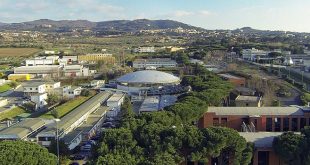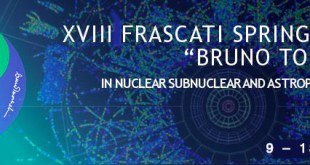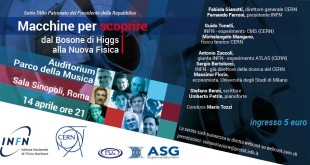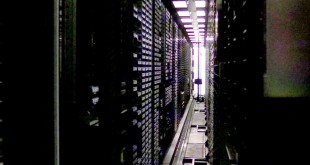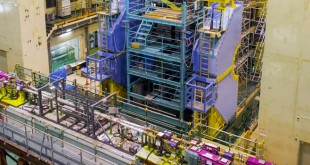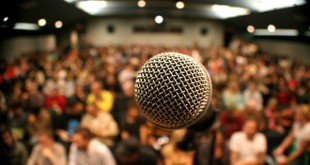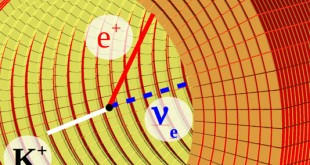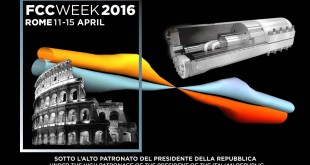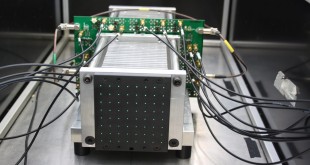It’s now come to an end the BTF (Beam Test Facility) measurements campaign for the characterization of one of the most innovative silicon pixel chips that will be used by the ALICE experiment for the new tracker detector. The building of a new ITS (Inner Tracking System) entirely based on silicon pixel detectors, made up of 7 concentric layers, for a total active surface of about 10 m2 of segmented silicon and more than 12.5 billion pixels, greatly involves the INFN, especially the ALICE group at LNF, which will be one of the five laboratories in the whole world to engage in this particular construction.
Read More »News
The LNF on the top of a rank of the MEF
I Laboratori Nazionali di Frascati (LNF), insieme ai Laboratori Nazionali di Legnaro (LNL), sono in vetta alla classifica degli enti pubblici più virtuosi nel pagamento delle fatture. A sancirlo l’ultima rilevazione del Ministero dell’Economia e delle Finanze (MEF), pubblicata all’inizio di aprile del 2016.
Read More »XVIII Spring School
The XVIII Spring School of the Frascati National Laboratories will be held this year from Monday, May 9th to Friday, May 13th. The program includes six sets of theoretical/experimental lectures on Dark Matter (A. Ibarra/M. Schumann), Neutrinoless Double Beta Decay (W. Rodejohann/S. Schönert), Searches for New Particles at the LHC (T. Plehn/O. Buchmueller) and the Spring School Colloquium “The SETI Project – Explore, understand and explain the origin, nature and prevalence of life in the Universe” delivered by the Director of the Center for SETI research, Professor Seth Shostak.
Read More »Macchine per scoprire
Conferenza pubblica: Macchine per scoprire – dal Bosone di Higgs alla Nuova Fisica 14 aprile – ore 21:00 AUDITORIUM Parco della Musica In occasione di FCC Week 2016, INFN e CERN collaborano per fornire ai ricercatori italiani un’importante occasione di raccontare le ricerche in corso al gigantesco acceleratore di particelle LHC e le sfide che si prospettano per la fisica, in questo momento costellato da importanti scoperte. Un confronto a più voci in cui si parlerà anche dell’impatto di tecnologie e infrastrutture sull’economia e sulla società.
Read More »KLOE-2 – New tape library to improve data storage
KLOE-2 is the main experiment of the Laboratori Nazionali di Frascati and presently acquiring data at the DAFNE accelerator. Upgraded with new detectors, KLOE-2 exhibits a greatly improved discovery potential with respect to previous KLOE experiment, including quantum interference with neutral K mesons and high precision study of the intrinsic properties of matter particles (kaon) with respect to anti-matter particles (anti-kaon).
Read More »The first beams are circulating in the SuperKEKB accelerator
On 2 march 2016, electron and positron beams were injected and stably circulated for the first time in the rings of the SuperKEKB accelerator at the KEK laboratory in Tsukuba, Japan. The important milestone, involving the creation of a high luminosity machine, is based on a beam collision scheme developed at the Frascati Laboratories for the Dafne accelerator.
Read More »It’s Science time: Seminari & Eventi 2016
Ripartono gli appuntamenti con la scienza ai Laboratori INFN di Frascati con un ricco programma di Seminari ed Eventi divulgativi rivolti a studenti, docenti e appassionati di ogni età.
Read More »A new generation of neutrino beams: ERC awards A. Longhin of INFN Frascati
With a 2 million EUR funding for a duration of 5 years the European Research Council (ERC) has awarded the ENUBET project (Enhanced NeUtrino Beams from kaon Tagging). The Principal Investigator is Andrea Longhin, a researcher working at the Frascati INFN National Laboratories. Longhin is among the 302 researchers awarded at an international level this year (with 585 MEUR in total) with the so-called “Consolidator Grants” of the ERC(*). This funding is meant, on a competitive basis, to offer researchers an extraordinary opportunity to make innovative and excellent research programs come to life.
Read More »FCCWEEK2016 – Future Circular Collider study
Rome, 11-15 April 2016 The Future Circular Collider Study (FCC) explores different designs of circular colliders for the post-LHC era. Reaching higher energies and unprecedented luminosities would allow us to explore the fundamental laws of nature and probe yet unexplained observations.
Read More »From the university of Insubria for the first experience as “researchers”
Six third year students of the BSc programme in physics at the University of Insubria (Varese-Como) spent five days at the Beam Test Facility (BTF) of the Frascati National Laboratories to study the behaviour of a calorimeter.
Read More » INFN-LNF Laboratori Nazionali di Frascati
INFN-LNF Laboratori Nazionali di Frascati
